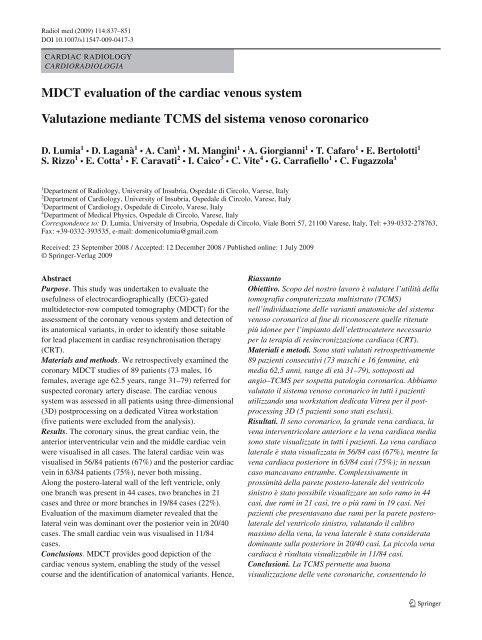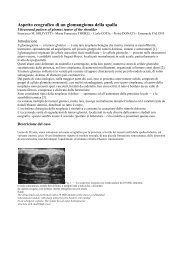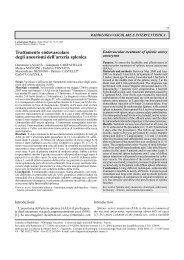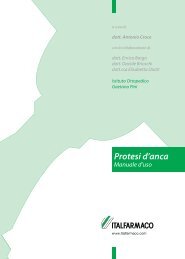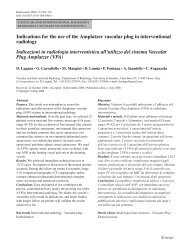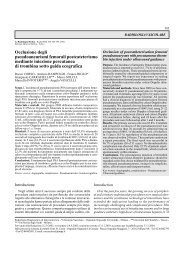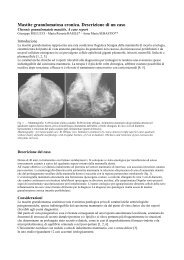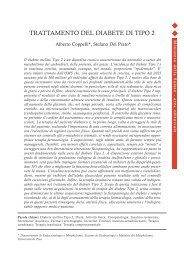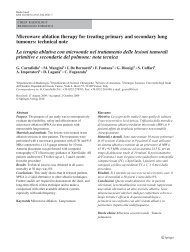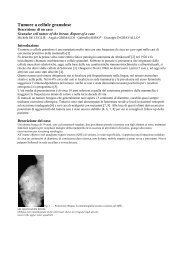MDCT evaluation of the cardiac venous system ... - Springer
MDCT evaluation of the cardiac venous system ... - Springer
MDCT evaluation of the cardiac venous system ... - Springer
Create successful ePaper yourself
Turn your PDF publications into a flip-book with our unique Google optimized e-Paper software.
840 Radiol med (2009) 114:837–851Table 1 Clinical characteristics <strong>of</strong> <strong>the</strong> study populationStudy populationDemographic characteristicsNumber <strong>of</strong> patients (M/F) 89 (73/16)Included patients 84 (71/13)Age (average±SD; range) 62.5±8.9; 31–79Heart rate (bpm) (average±SD; range) 62.2±4.3; 52–70SymptomsStable angina (%) 25 (29.8%)Unstable angina (%) 4 (4.8%)Atypical chest pain 19 (22.6%)Stent follow-up 10 (11.9%)By-pass follow-up 15 (17.8%)Suspected coronary abnormalities 2 (2.4%)Valve replacement planning 9 (10.7%)Cardiovascular risk factorsHypertension (%) 63 (75%)Hyperlipidaemia (%) 39 (46%)Diabetes (%) 46 (55%)Smoke (%) 24 (29%)Familial (%) 37 (44%)Obesity (%) 15 (18%)NYHA classificationNYHA I (absence <strong>of</strong> dyspnoea, chestpain or palpitations after severe physicalexertion) 45NYHA II (dyspnoea, chest pain orpalpitations after sustained physical exertion) 28NYHA III (dyspnoea, chest pain orpalpitations after mild physical exertion) 10NYHA IV (dyspnoea, chest pain orpalpitations at rest) 1Ejection fraction <strong>of</strong> <strong>the</strong> ventricle (LVEF)Normal (≥50%) 53Moderately impaired (35%–50%) 29Impaired (
842 Radiol med (2009) 114:837–851abcdFig. 1a-d Normal anatomy <strong>of</strong> <strong>the</strong> coronaryveins (3D VR reconstruction). The AIV arisesfrom <strong>the</strong> <strong>cardiac</strong> apex and runs in <strong>the</strong> anteriorinterventricular groove parallel to <strong>the</strong> left anteriordescending artery. Near <strong>the</strong> LM bifurcation,it opens into <strong>the</strong> GCV, which lies in <strong>the</strong>left atrioventricular groove close to <strong>the</strong> leftcircumflex artery and in turn opens into <strong>the</strong>CS. Tributaries <strong>of</strong> <strong>the</strong> GCV are <strong>the</strong> lateral(LCV) and posterior (PCV) <strong>cardiac</strong> veinsrunning across <strong>the</strong> posterolateral wall <strong>of</strong> <strong>the</strong>left ventricle. The MCV lies in <strong>the</strong> posteriorinterventricular groove and opens into <strong>the</strong> CS.CS, coronary sinus; GCV, great <strong>cardiac</strong> vein;AIV, anterior interventricular vein; MCV,middle <strong>cardiac</strong> vein; LCV, lateral (alsomarginal) <strong>cardiac</strong> vein; PCV, posterior <strong>cardiac</strong>vein; SCV, small <strong>cardiac</strong> vein; LM, left maincoronary artery; D1, first diagonal; MO, obtusemarginal.Fig. 1a-d Anatomia normale delle vene coronariche(ricostruzioni 3D VR). L’AIV originadall’apice <strong>cardiac</strong>o, decorrendo nel solcointerventricolare anteriore parallelamenteall’arteria discendente anteriore. A livellodella biforcazione del LM termina nella GCV,che giace nel solco atrio-ventricolare sinistroin vicinanza dell’arteria circonflessa fino aterminare nel CS. Tributarie della GCV sonola vene laterali (LCV) e posteriori (PCV), chedecorrono sulla faccia postero-laterale delventricolo sinistro. La MCV giace nel solcointerventricolare posteriore e sbocca nel CS.CS, seno coronario; GCV, grande vena<strong>cardiac</strong>a; AIV, vena inter-ventricolare anteriore;MCV, vena <strong>cardiac</strong>a media; LCV, vena<strong>cardiac</strong>a laterale; PCV, vena <strong>cardiac</strong>a posteriore;SCV, piccola vena <strong>cardiac</strong>a; LM, troncocomune; D1, primo diagonale; MO, marginaleottuso.The distance between <strong>the</strong> postero-lateral veins and <strong>the</strong> CSwas 62.51±32.5 mm for <strong>the</strong> PCV and 58.66±32.0 mm for <strong>the</strong>LCV. The angle between <strong>the</strong> postero-lateral veins and <strong>the</strong>GCV resulted 90° in four patients(6.3%) for <strong>the</strong> PCV and in three patients (5.4%) for <strong>the</strong> LCV.The mean diameters <strong>of</strong> CS and GCV were 15.3 mm and 7.6mm, respectively. The mean diameters <strong>of</strong> <strong>the</strong> o<strong>the</strong>r tributaries<strong>of</strong> <strong>the</strong> CS were as follows: AIV 3.2 mm, MCV 4.6mm, LCV 2.6 mm, PCV 3.4 mm and SCV 2.2 mm (Table 3).Therefore, in 79 <strong>of</strong> <strong>the</strong> 84 patients (94%) who underwent<strong>MDCT</strong> coronary angiography for suspected CAD, at leastone <strong>venous</strong> branch with good diameter and regular coursewas identified along <strong>the</strong> postero-lateral wall <strong>of</strong> <strong>the</strong> leftventricle. In 5/84 patients (6%), <strong>the</strong> postero-lateral branchhad a short course (
Radiol med (2009) 114:837–851 843Fig. 2 Multiplanar reconstruction (MPR) <strong>of</strong> <strong>the</strong> coronary <strong>venous</strong> <strong>system</strong>. The image displays <strong>the</strong> coronary sinus (CS), <strong>the</strong> great <strong>cardiac</strong> vein (GCV), <strong>the</strong>anterior interventricular vein (AIV) and <strong>the</strong> middle <strong>cardiac</strong> vein (MCV). Mean diameters are calculated on multiplanar reconstruction (MPR) images (asshown in <strong>the</strong> figure).Fig. 2 Ricostruzione multiplanare (MPR) del sistema venoso coronarico. La figura mostra il seno coronarico (CS), la grande vena <strong>cardiac</strong>a (GCV), lavena interventricolare anteriore (AIV) e la vena <strong>cardiac</strong>a media (MCV). I diametri principali sono calcolati sulle immagini MPR (come mostrato infigura).abcFig. 3a-c Cardiac resynchronisation <strong>the</strong>rapy (CRT): <strong>MDCT</strong> planning and balloonvenography during <strong>the</strong> procedure. a) 3D VR reconstruction: presence <strong>of</strong> a good diameterPCV. b) Balloon retrograde angiography during <strong>the</strong> lead placement procedure for CRT(angiographic view <strong>of</strong> <strong>the</strong> coronary sinus and its tributaries filled with contrast media). c)Angiography: correct lead placement at <strong>the</strong> end <strong>of</strong> <strong>the</strong> procedure. CS, coronary sinus;GCV, great <strong>cardiac</strong> vein; AIV, anterior interventricular vein; MCV, middle <strong>cardiac</strong> vein;LCV, lateral <strong>cardiac</strong> vein; PCV, posterior <strong>cardiac</strong> vein.Fig. 3a-c Terapia di resincronizzazione <strong>cardiac</strong>a (CRT): planning TCMS e venografia conpallone occludente durante la procedura. a) Ricostruzione 3D-VR: presenza di una PCV dibuon calibro. b) Venografia retrograda con pallone occludente durante la procedura diimpianto dell’elettrocatetere per la CRT (visualizzazione angiografica del seno coronaricoe delle sue vene tributarie opacizzate dal mezzo di contrasto). c) Immagine angiografica:corretto posizionamento dell’elettrocatetere al termine della procedura. CS, seno coronario;GCV, grande vena <strong>cardiac</strong>a; AIV, vena interventricolare anteriore; MCV, vena<strong>cardiac</strong>a media; LCV, vena <strong>cardiac</strong>a laterale; PCV, vena <strong>cardiac</strong>a posteriore.
844 Radiol med (2009) 114:837–851abLa distanza delle vene della parete postero-laterale dalCS è risultata 62,51±32,5 cm per la PCV e di 58,66±32 cmper la LCV. L’angolo di raccordo dei rami venosi dellaparete postero-laterale è apparso inferiore a 90° in 59pazienti (93,7%) in corrispondenza della PCV e in 53pazienti (94,6%) in corrispondenza della LCV, superiore a90° in 4 pazienti (6,3%) in corrispondenza della PCV e in 3pazienti (5,4%) in corrispondenza della LCV. Il diametromedio del CS è risultato 15,3 mm, quello della GCV 7,6 mm.I diametri medi delle altre vene tributarie del seno coronaricosono risultati rispettivamente: AIV 3,2 mm, MCV4,6 mm, LCV 2,6 mm, PCV 3,4 mm e PVC 2,2 mm (Tabella3). Quindi in 79 degli 84 pazienti (94%) sottoposti adangio-TCMS coronarica per sospetta CAD, è stato possibilevisualizzare almeno un ramo venoso di buon calibro edecorso regolare in corrispondenza della parete posterolateraledel ventricolo sinistro; in 5/84 pazienti (6%) ilramo venoso postero-laterale visualizzato presentava brevedecorso (
Radiol med (2009) 114:837–851 845Table 3 Detection rates and mean diameters <strong>of</strong> <strong>the</strong> coronary sinus and its tributaries in <strong>the</strong> personal series and data reported in <strong>the</strong> LitteratureVeins Personal series LiteratureNumber Diameter Number DiameterCS 84/84 (100%) 15.3 333/340 (98%) 13.2GCV 84/84 (100%) 7.6 160/161 (98%) 6.8MCV 84/84 (100%) 4.6 332/340 (98%) 5.2AIV 84/84 (100%) 3.2 210/211 (99%) 3.9PCV 63/84 (75%) 3.4 302/340 (89%) 3.9LCV 56/84 (67%) 2.6 250/340 (73%) 3.7SCV 11/84 (13%) 2.2 47/340 (14%) –CS, coronary sinus; GCV, great <strong>cardiac</strong> vein; MCV, middle <strong>cardiac</strong> vein; AIV, anterior interventricular vein; PCV, posterior <strong>cardiac</strong> vein; LCV, lateral <strong>cardiac</strong>vein; SCV, small <strong>cardiac</strong> veinTabella 3 Percentuali di visualizzazione e diametri medi delle vene tributarie del seno coronarico nella casistica personale e dati riportati in LetteraturaVene Casistica LetteraturaNumero Diametro Numero DiametroCS 84/84 (100%) 15,3 333/340 (98%) 13,2GCV 84/84 (100%) 7,6 160/161 (98%) 6,8MCV 84/84 (100%) 4,6 332/340 (98%) 5,2AIV 84/84 (100%) 3,2 210/211 (99%) 3,9PCV 63/84 (75%) 3,4 302/340 (89%) 3,9LCV 56/84 (67%) 2,6 250/340 (73%) 3,7SCV 11/84 (13%) 2,2 47/340 (14%) –CS, seno coronarico; GCV, grande vena <strong>cardiac</strong>a; MCV, vena <strong>cardiac</strong>a media; AIV, vena interventricolare anteriore; PCV, vena <strong>cardiac</strong>a posteriore;LCV, vena <strong>cardiac</strong>a laterale; SCV, piccola vena <strong>cardiac</strong>asatisfactory results, and <strong>the</strong> association <strong>of</strong> several drugs maybe poorly tolerated by elderly patients. This has led to <strong>the</strong>development <strong>of</strong> alternative treatments [11, 14].CRT is an innovative approach to <strong>the</strong> patient affected bychronic heart failure [9, 10, 12]. CRT acts on <strong>cardiac</strong>mechanics through <strong>the</strong> implantation <strong>of</strong> a biventricular pacemakerthat restores <strong>the</strong> correct synchronisation <strong>of</strong> <strong>the</strong>activity <strong>of</strong> <strong>the</strong> atria and ventricles. The results are improvedclinical condition, quality <strong>of</strong> life and outcome <strong>of</strong> patientsaffected by advanced chronic heart failure associated withincreased QRS duration. The technique involves implantation<strong>of</strong> three pacing leads to stimulate <strong>the</strong> right atrium, <strong>the</strong>right ventricle and <strong>the</strong> left ventricle [9, 15–18].For lead implantation, an intravascular approach with<strong>venous</strong> access is preferable to minimally invasive thoracicsurgery because <strong>of</strong> <strong>the</strong> obvious advantage <strong>of</strong> sparing generalanaes<strong>the</strong>sia and surgical trauma for patients with unstablehaemodynamic status. The pacing leads destined for <strong>the</strong>right heart chambers can be positioned through a central<strong>venous</strong> ca<strong>the</strong>ter, generally with access from <strong>the</strong> left subclavianvein. Stimulation <strong>of</strong> <strong>the</strong> left ventricle is performed witha usually bipolar pacing lead specially developed for placementin a <strong>cardiac</strong> vein, which is reached through ca<strong>the</strong>terisation<strong>of</strong> <strong>the</strong> CS.The CS is a large vein that runs across <strong>the</strong> diaphragmaticsviluppato per l’impianto in una vena <strong>cardiac</strong>a, che vieneraggiunta mediante cateterizzazione del CS.Il CS è una grossa vena che decorre sulla facciadiaframmatica del cuore (Fig. 1) nella metà sinistra delsolco atrio-ventricolare posteriore [15]. L’ostio del CS èprovvisto di un residuo valvolare di forma semilunare, lavalvola di Tebesio [16, 17]. La maggiore tra le veneaffluenti del seno coronarico è la GCV (Fig. 1) chedall’apice <strong>cardiac</strong>o decorre nel solco interventricolareanteriore e il solco atrio-ventricolare sinistro sino aconfluire nel CS [17]. La MCV (Fig. 1a) decorre lungo ilsolco interventricolare posteriore sino a raggiungereanch’essa nella maggioranza dei casi il CS poco prima delsuo sbocco. Il CS riceve inferiormente la PCV, che originadalla parete posteriore del ventricolo stesso, e superiormentela vena obliqua dell’atrio sinistro (o di Marshall), laquale discende medialmente dalla parete posteriore di taleatrio [15–17]. La LCV drena la parete laterale del ventricolosinistro confluendo nella GCV. La PCV e la LCV nonsono presenti in tutti i pazienti. La SCV (Fig. 1a) prendeorigine dal margine acuto del cuore e decorre sulla suafaccia diaframmatica, confluendo nel CS in prossimità delsuo sbocco in atrio destro [18].La presenza di un appropriato ramo venoso del senocoronarico è quindi cruciale per un corretto approccio
846 Radiol med (2009) 114:837–851surface <strong>of</strong> <strong>the</strong> heart (Fig. 1) in <strong>the</strong> left half <strong>of</strong> <strong>the</strong> posterioratrio-ventricular groove [15]. The ostium <strong>of</strong> <strong>the</strong> CS isguarded by a rudimentary semicircular valve, <strong>the</strong> Thebesianvalve [16, 17]. The largest <strong>of</strong> <strong>the</strong> CS tributaries is <strong>the</strong> GCV(Fig. 1), which arises from <strong>the</strong> <strong>cardiac</strong> apex and runs across<strong>the</strong> anterior interventricular groove and <strong>the</strong> left atrioventriculargroove to open into <strong>the</strong> CS [17]. The MCV (Fig.2a) runs along <strong>the</strong> posterior interventricular groove and inmost cases also opens into <strong>the</strong> CS just prior to its outlet.The CS also receives inferiorly <strong>the</strong> PCV, which arises from<strong>the</strong> posterior wall <strong>of</strong> <strong>the</strong> left ventricle, and superiorly <strong>the</strong>oblique vein <strong>of</strong> <strong>the</strong> left atrium (Marshall veins), whichdescends medially from <strong>the</strong> posterior wall <strong>of</strong> <strong>the</strong> atrium [15,17]. The LCV drains <strong>the</strong> lateral wall <strong>of</strong> <strong>the</strong> left ventricle andopens into <strong>the</strong> GCV. The PCV and <strong>the</strong> LCV are not presentin all subjects. The SCV (Fig. 1a) arises from <strong>the</strong> acutemargin <strong>of</strong> <strong>the</strong> heart, runs along its diaphragmatic surfaceand opens into <strong>the</strong> CS near its outlet into <strong>the</strong> right atrium[18].The presence <strong>of</strong> an appropriate <strong>venous</strong> branch <strong>of</strong> <strong>the</strong> CSis <strong>the</strong>refore crucial for correct trans<strong>venous</strong> approach andplacement <strong>of</strong> <strong>the</strong> pacing lead in <strong>the</strong> medial or basal region <strong>of</strong><strong>the</strong> free wall <strong>of</strong> <strong>the</strong> left ventricle, ei<strong>the</strong>r in a lateral orpostero-lateral vein, which is <strong>the</strong> area <strong>of</strong> <strong>the</strong> left ventriclemost commonly affected by desynchronisation [13].For this reason not all patients are candidates for CRTdue to <strong>the</strong> absence <strong>of</strong> a <strong>cardiac</strong> vein with a sufficiently largediameter or a sufficient length to accommodate <strong>the</strong> pacinglead, or due to impediments to <strong>the</strong> ca<strong>the</strong>terisation procedure.The possibility <strong>of</strong> obtaining a detailed visualisation <strong>of</strong> <strong>the</strong><strong>cardiac</strong> <strong>venous</strong> <strong>system</strong> is <strong>the</strong>refore a valuable aid duringplanning for implantation <strong>of</strong> biventricular pacemakers [19].Retrograde <strong>venous</strong> angiography with occlusive balloon iscurrently <strong>the</strong> conventional technique for studying <strong>the</strong> coronaryveins [9, 20]. This technique is performed with <strong>the</strong>injection <strong>of</strong> contrast agent during selective ca<strong>the</strong>terisation <strong>of</strong><strong>the</strong> CS and tributary veins. A complete study requires atleast two fluoroscopic views in order to clearly visualise <strong>the</strong>anatomy, <strong>the</strong> angulation and <strong>the</strong> course <strong>of</strong> each vein [16].The limitations <strong>of</strong> this technique include invasiveness,examination duration, a not always optimal depiction <strong>of</strong> <strong>the</strong><strong>cardiac</strong> veins, an inability to visualise both <strong>the</strong> vessels and<strong>the</strong> <strong>cardiac</strong> wall at <strong>the</strong> same time, a need for large amounts<strong>of</strong> contrast agent (in some cases up to 500 ml per examination)and <strong>the</strong> impossibility to selectively ca<strong>the</strong>terise <strong>the</strong> CSand its tributaries in 4%–5% <strong>of</strong> patients [10, 16, 20–22].In recent years, <strong>MDCT</strong> has been taking on an increasinglyimportant role as a noninvasive modality for studying<strong>the</strong> <strong>cardiac</strong> veins, thanks to its high spatial and temporalresolution, <strong>cardiac</strong> gating and sophisticated image postprocessingand reconstruction techniques, which are able toproduce detailed visualisation <strong>of</strong> <strong>the</strong> <strong>cardiac</strong> <strong>venous</strong> <strong>system</strong>[20–27].trans-venoso ed impianto dell’elettrocatetere in corrispondenzadella regione mediale o basale della parete libera delventricolo di sinistra, in una vena laterale o postero-laterale,zona del ventricolo sinistro che risulta essere quella maggiormentecolpita dal processo di desincronizzazione [13].Non tutti i pazienti risultano candidabili alla CRT, acausa dell’assenza di una vena <strong>cardiac</strong>a di calibro olunghezza adeguata ad alloggiare l’elettrocatetere o per lapresenza di ostacoli alla procedura di cateterizzazione. Lapossibilità di ottenere una visualizzazione dettagliata delsistema venoso <strong>cardiac</strong>o risulta perciò preziosa nella pianificazionedella procedura di impianto dei pacemaker biventricolari[19].L’angiografia venosa retrograda con pallone occludente,attualmente rappresenta la metodica convenzionaledi studio delle vene coronariche [9, 20]: viene ottenutamediante iniezione di MdC durante cateterizzazione selettivadel seno coronarico e delle vene tributarie. Per unostudio completo sono necessarie almeno due proiezionifluoroscopiche, in modo da evidenziare chiaramentel’anatomia, l’angolazione ed il decorso di ogni vena [16]. Ilimiti di questa metodica sono da ricercare nell’invasivitàdella procedura, nella durata dell’esame, nella visualizzazionenon sempre ottimale delle vene <strong>cardiac</strong>he, nell’impossibilitàdi visualizzare contemporaneamente i vasi e laparete <strong>cardiac</strong>a, nella necessità di impiegare grandi quantitàdi MdC (in alcuni casi fino a 500 ml per esame) edinfine nell’impossibilità, riscontrata nel 4%–5% deipazienti, di procedere al cateterismo selettivo del seno coronaricoe delle vene tributarie [10, 16, 20–22].In questi ultimi anni la TCMS, grazie all’elevata risoluzionespaziale e temporale, alle tecniche di gating <strong>cardiac</strong>o,alle s<strong>of</strong>isticate capacità di processazione e ricostruzionedelle immagini, che consentono di ottenere una visualizzazionedettagliata dell’anatomia del sistema venoso coronarico,si sta proponendo come metodica non invasiva per lostudio delle vene <strong>cardiac</strong>he [20–27].L’esame TCMS nel planning di CRT permette una preliminarevalutazione dell’anatomia del sistema venoso coronarico,del calibro del seno coronario, del calibro edell’estensione delle vene coronariche passibili di cateterizzazioneed impianto di elettrodo stimolatore; deve essereinfatti esclusa la presenza di condizioni anatomiche chepossono creare un possibile ostacolo al corretto posizionamentodell’elettrodo bipolare, come la presenza nel senocoronarico di lembi valvolari accessori (Tebesio o Vieussens),la presenza di particolari configurazioni del senocoronarico (bifido, “high riding”, varicoide, filiforme,“windsock” o ectasico, diverticolare, atresico) (Fig. 5), lapresenza di un decorso dell’arteria circonflessa che“scavalca” la GVC determinandone la sua compressione“ab estrinseco” ed infine la presenza angoli di confluenzadelle vene <strong>cardiac</strong>he della parete postero-laterale con la
Radiol med (2009) 114:837–851 847a b cd e fFig. 5a-f Normal anatomy and variants <strong>of</strong> <strong>the</strong> coronary sinus (<strong>MDCT</strong> 3D volume-rendered reconstruction): normal anatomy (a), bifid CS (b), high-ridingCS (c), varicoid CS (d), filiform CS (e), CS windsock or ectatic CS (f). CS: coronary sinus.Fig. 5a-f Anatomia normale e varianti del sistema venoso del seno coronarico (TCMS ricostruzioni 3DVR): anatomia normale (a), SC bifido (b), SC “highriding” (c), SC varicoide (d), SC filiforme (e), SC “windsock” o ectasico (f). CS: seno coronario.In <strong>the</strong> planning <strong>of</strong> CRT, <strong>the</strong> <strong>MDCT</strong> examination enablesa preliminary <strong>evaluation</strong> <strong>of</strong> <strong>the</strong> anatomy <strong>of</strong> <strong>the</strong> <strong>cardiac</strong><strong>venous</strong> <strong>system</strong>, <strong>of</strong> <strong>the</strong> diameter <strong>of</strong> <strong>the</strong> CS, and <strong>of</strong> <strong>the</strong> diameterand length <strong>of</strong> <strong>the</strong> <strong>cardiac</strong> veins suitable for ca<strong>the</strong>terisationand pacing lead implantation. The presence <strong>of</strong> anatomicalconditions unsuitable for correct placement <strong>of</strong> <strong>the</strong>bipolar lead needs to be ruled out, such as accessory valveleaflets (Thebesian or Vieussens) in <strong>the</strong> CS, certain anatomicalconfigurations <strong>of</strong> <strong>the</strong> CS (bifid, high riding, varicoid,filiform, windsock or ectatic, diverticular, atresic) (Fig.5a–f), a left circumflex artery crossing <strong>the</strong> GCV and causingexternal compression, and unfavourable angles between <strong>the</strong>GCV non favorevoli (≥90°) ad un’agevole cateterizzazione.L’intento del nostro lavoro non è quello di analizzarel’accuratezza diagnostica della TCMS nei confronti dellavenografia, ma di far risaltare i vantaggi che possono derivaredall’utilizzo routinario della TCMS nella valutazionedel sistema venoso coronarico. In letteratura sono riportatepercentuali di visualizzazione dei diversi segmenti venosicoronarici, variabili in relazione al calibro dei vasi considerati:il CS è stato visualizzato nel 98% dei casi, la GCVnel 99% dei casi, la AIV nel 99% dei casi, la MCV nel 98%dei casi, la PVC nel 89% dei casi, la LCV nel 73% dei casi,la PVC nel 14% dei casi. Il diametro medio del CS è
848 Radiol med (2009) 114:837–851postero-lateral veins and <strong>the</strong> GCV (≥90°).The aim <strong>of</strong> our study was not to analyse <strong>the</strong> diagnosticaccuracy <strong>of</strong> <strong>MDCT</strong> compared with venography but, ra<strong>the</strong>r, tohighlight <strong>the</strong> advantages <strong>of</strong> <strong>the</strong> routine use <strong>of</strong> <strong>MDCT</strong> in <strong>the</strong><strong>evaluation</strong> <strong>of</strong> <strong>the</strong> coronary <strong>venous</strong> <strong>system</strong>. The Literaturereports detection rates <strong>of</strong> <strong>the</strong> various <strong>venous</strong> segments thatvary in relation to <strong>the</strong> diameter <strong>of</strong> <strong>the</strong> vessels considered. TheCS was visualised in 98% <strong>of</strong> cases, <strong>the</strong> GCV in 99%, <strong>the</strong>AIV in 99%, <strong>the</strong> MCV in 98%, <strong>the</strong> PCV in 89%, <strong>the</strong> LCV in73% and <strong>the</strong> SCV in 14% <strong>of</strong> cases. The mean diameters <strong>of</strong><strong>the</strong> CS tributaries were 3.9 mm for <strong>the</strong> IAV, 5.2 mm for <strong>the</strong>MCV, 3.9 mm for <strong>the</strong> PCV and 3.7 mm for <strong>the</strong> LCV [20–27].The reported detection rates <strong>of</strong> <strong>the</strong> <strong>cardiac</strong> veins are, to alarge extent, similar to those in our study with <strong>the</strong> exception<strong>of</strong> <strong>the</strong> LCV (73% vs. 67% in our series) and more notably <strong>of</strong><strong>the</strong> PCV (89% vs. 75%). Possible explanations for thisdiscrepancy include nonoptimal timing <strong>of</strong> contrast enhancement,much faster scan times with respect to <strong>the</strong> earlier multislicescanners (4- 8- and 16 slices) and interobserver variabilityin <strong>the</strong> linear measurements <strong>of</strong> vessel diameter.Even though postprocessing <strong>of</strong> new-generation angiographicimages makes possible <strong>the</strong> creation <strong>of</strong> 3D volumerendering (VR) reconstructions immediately after retrogradevenography [28] and linear measurements on 2Dimages, <strong>the</strong> VR and MPR images created from <strong>MDCT</strong>acquisitions with isotropic voxels may provide additionaladvantages. In addition to clearly depicting <strong>the</strong> course<strong>of</strong> <strong>the</strong> vessel in relation to <strong>the</strong> left ventricular free wall and<strong>the</strong> left circumflex artery [28], <strong>the</strong>se reconstructions <strong>of</strong>fer<strong>the</strong> possibility <strong>of</strong> evaluating <strong>the</strong> anatomy <strong>of</strong> <strong>the</strong> mitralvalve and enable precise measurement <strong>of</strong> <strong>the</strong> diameter, orbetter <strong>of</strong> <strong>the</strong> section, <strong>of</strong> <strong>the</strong> CS and its branches.The presence <strong>of</strong> reduced diameters, short vessels orsharp vascular angles can in fact make difficult or evenimpossible <strong>the</strong> insertion <strong>of</strong> <strong>the</strong> bipolar pacing [10, 16,21–23].Normally <strong>the</strong> anatomy <strong>of</strong> <strong>the</strong> <strong>cardiac</strong> veins is not optimallyvisualised with <strong>the</strong> contrast-enhancement protocolused for <strong>the</strong> coronary arteries, with <strong>the</strong> exception <strong>of</strong> <strong>the</strong>juxta-atrial portions (CS and MCV). This occurs because<strong>the</strong> veins situated more cranially, when <strong>the</strong> acquisitions areperformed in <strong>the</strong> cranio-caudal direction, show validcontrast enhancement towards <strong>the</strong> end <strong>of</strong> <strong>the</strong> scan [1].Undoubtedly, <strong>the</strong> visibility <strong>of</strong> <strong>the</strong> <strong>cardiac</strong> veins on <strong>the</strong>postero-lateral wall <strong>of</strong> <strong>the</strong> left ventricle could be improved byperforming <strong>the</strong> scan in <strong>the</strong> caudo-cranial direction or by usingan additional delay <strong>of</strong> 12–15 s after reaching <strong>the</strong> enhancementthreshold in <strong>the</strong> ascending aorta (baseline HU+100 HU)[1, 2, 17]. Ano<strong>the</strong>r expedient, which is <strong>the</strong> subject <strong>of</strong> astudy at our centre, is <strong>the</strong> simultaneous use <strong>of</strong> two ROIscorresponding to <strong>the</strong> CS and <strong>the</strong> ascending aorta. Althroughour experience is still limited, this bolus-tracking method,which does not appear to be reported in <strong>the</strong> Literature,risultato 13,2 mm, quello della GCV 6,8 mm. I diametrimedi delle altre vene tributarie del seno coronarico sonorisultati rispettivamente: AIV 3,9 mm, MCV 5,2 mm, PVC3,9 mm e LCV 3,7 mm [20–27]. I dati riguardanti la percentualedi visualizzazione delle vene <strong>cardiac</strong>he riportati inletteratura sono in buona parte sovrapponibili ai dati estrapolatidalla nostra esperienza fatta eccezione per la visualizzazionedella LCV (73% vs 67% letteratura vs nostracasistica) ed in maniera ancora più significativa della PVC(89% vs 75%). È possibile che il motivo di tali discrepanzerisieda in un timing contrastografico non ottimizzato, intempi di scansione estremamente più veloci rispetto ai primiscanner multi-slice (4-8-16 strati) ed infine nella variabilitàinter-osservatore delle misure lineari del diametro vasale.Nonostante le implementazioni degli angiografi di nuovagenerazione permettano di creare in post-processing immagini3D volume rendering (VR) subito dopo l’esecuzionedella venografia retrograda [28] e di eseguire misurazionilineari su immagini bidimensionali, le ricostruzioni VR eMPR ricavate da acquisizioni TCMS con voxel isotropico,possono fornire ulteriori vantaggi. Queste ricostruzioni,oltre che mettere bene in evidenza il decorso dei vasi inrelazione alla parete libera del ventricolo di sinistra eall’arteria circonflessa [28] <strong>of</strong>frono la possibilità di valutarel’anatomia dell’anello mitralico e consentono di misurarein maniera precisa il diametro, o ancor meglio lasezione, del seno coronarico e dei suoi rami; la presenza dicalibri ridotti, di vasi a breve decorso o di brusche angolazionivasali, possono infatti rendere difficoltoso, o addiritturaimpossibile, l’inserimento dell’elettrocatetere bipolaredurante la procedura di CRT [10, 16, 21–23].Normalmente l’anatomia delle vene <strong>cardiac</strong>he non vienevisualizzata in maniera ottimale applicando il protocollo distudio contrastografico utilizzato per le arterie coronarie,ad eccezione delle porzioni iuxta-atriali (seno coronarico evena <strong>cardiac</strong>a media). Questo avviene perché le venesituate più cranialmente, quando l’acquisizione viene effettuatain senso cranio-caudale, presentano un validocontrast enhancement verso il termine della scansione [1].Sicuramente effettuare l’acquisizione della scansione indirezione caudo-craniale o l’utilizzo di un ritardo aggiuntivodi 12–15 secondi dal raggiungimento della soglia di attenuazionein aorta ascendente [HU basale+100 HU], consente dimigliorare la visibilità delle vene <strong>cardiac</strong>he lungo la paretepostero-laterale del ventricolo sinistro [1, 2, 17]. Un ulterioreaccorgimento, attualmente oggetto di studio presso ilnostro centro, è l’utilizzo contemporaneo di due regioni diinteresse (ROI) in corrispondenza del seno coronarico edell’aorta discendente; questa modalità di bolus tracking,che non ci risulta essere mai stata descritta, nella nostra casisticaseppure ancor limitata, permetterebbe di ridurre alminimo la criticità del timing contrastografico del sistemavenoso coronarico, specie in pazienti che a causa della
850 Radiol med (2009) 114:837–851Conflict <strong>of</strong> interest statement The authors declare that <strong>the</strong>y have no conflict <strong>of</strong> interest to <strong>the</strong> publication <strong>of</strong> this article.References/Bibliografia1. Cademartiri F, Runza G, Belgrano M etal (2005) Introduction to coronaryimaging with 64-slice computedtomography. Radiol Med 110:16–412. Pannu HK, Flohr TG, Corl FM et al(2003) Current concepts in multidetectorrow CT <strong>evaluation</strong> <strong>of</strong> <strong>the</strong>coronary arteries: principles,techniques, and anatomy.Radiographics 23:S111–S1253. Schoepf UJ, Zwerner PL, Savino G etal (2007) Coronary CT angiography.Radiology 244:48–634. Halon DA, Rubinshtein R, Gaspar T etal (2008) Current status and clinicalapplications <strong>of</strong> <strong>cardiac</strong> multidetectorcomputed tomography. Cardiology109:73–845. Woodard PK, Bhalla S, Javidan-NejadC et al (2006) Non-coronary <strong>cardiac</strong>CT imaging. Semin Ultrasound CT MR27:56–756. Hendel RC, Patel MR, Kramer CM etal (2006)ACCF/ACR/SCCT/SCMR/ASNC/NASCI/SCAI/SIR 2006 Appropriatenesscriteria for <strong>cardiac</strong> computedtomography and <strong>cardiac</strong> magneticresonance imaging: a Report <strong>of</strong> <strong>the</strong>American College <strong>of</strong> CardiologyFoundation Quality Strategic DirectionsCommittee Appropriateness CriteriaWorking Group, American College <strong>of</strong>Radiology, Society <strong>of</strong> CardiovascularComputed Tomography, Society forCardiovascular Magnetic Resonance,American Society <strong>of</strong> NuclearCardiology, North American Societyfor Cardiac Imaging, Society forCardiovascular Angiography andInterventions, and Society <strong>of</strong>Interventional Radiology. J Am CollCardiol 48:1475–14977. Benini K, Marini M, Del Greco M et al(2008) Role <strong>of</strong> multidetector computedtomography in <strong>the</strong> anatomicaldefinition <strong>of</strong> <strong>the</strong> left atrium-pulmonaryvein complex in patients with atrialfibrillation. Personal experience andpictorial assay. Radiol Med113:779–7988. Cademartiri F, Runza G, Luccichenti Get al (2006) Coronary artery anomalies:incidence, pathophysiology, clinicalrelevance and role <strong>of</strong> diagnosticimaging. Radiol Med 111:376–3919. Abraham WT, Fisher WG, Smith AL etal (2002) Cardiac resynchronization inchronic heart failure. N Engl J Med346:1845–185310. Abraham WT, Hayes DL (2003)Cardiac resynchronization <strong>the</strong>rapy forheart failure. Circulation108:2596–260311. Gasparini G (2005) La stimolazioneatrio-ventricolare e biventricolare nelloscompenso <strong>cardiac</strong>o. It J PracticeCardiol 2:55–6012. Ghio S, Constantin C, Klersy C et al(2004) Interventricular andintraventricular dyssynchrony arecommon in heart failure patients,regardless <strong>of</strong> QRS duration. Eur Heart J25:571–57813. Cazeau S, Leclercq C, Lavergne T et al(2001) Effects <strong>of</strong> multisite biventricularpacing with heart failure andintraventricular conduction delay. NEngl J Med 344:873–88014. Bristow MR, Saxon LA, Boehmer J etal (2004) Cardiac resynchronization<strong>the</strong>rapy with or without an implantabledefibrillator in advanced chronic heartfailure. N Engl J Med 350:2140–215015. Pensa A, Favaro G, Cattaneo L (1996)Trattato di anatomia umana. EdizioneUTET, Torino16. Singh JP, Houser S, Heist EK et al(2005) The coronary <strong>venous</strong> anatomy: asegmental approach to aid <strong>cardiac</strong>resynchronization <strong>the</strong>rapy. J Am CollCardiol 46:68–7417. Cademartiri F, Marano R, LuccichentiG et al. (2004) Normal anatomy <strong>of</strong> <strong>the</strong>vessels <strong>of</strong> <strong>the</strong> heart with 16-rowmultislice Computed Tomography.Radiol Med 107:11–2318. Hewitt MJ, Chen JTT, Ravin CEet al (1981) Coronary Sinus atrialpacing: radiographic considerations.AJR Am J Roentgenol 136:323–32819. Vardas PE, Auricchio A, Blanc JJ et al(2007) Guidelines for <strong>cardiac</strong> pacingand <strong>cardiac</strong> resynchronization <strong>the</strong>rapy.The Task Force for Cardiac Pacing andCardiac Resynchronization Therapy <strong>of</strong><strong>the</strong> European Society <strong>of</strong> Cardiology.Developed in collaboration with <strong>the</strong>European Heart Rhythm Association.Europace 9:959–99820. Tada H, Kurosaki K, Naito S et al(2005) Three-dimensional visualization<strong>of</strong> <strong>the</strong> coronary <strong>venous</strong> <strong>system</strong> usingmultidetector row computedtomography. Circ J 69:165–17021. Abbara S, Cury RC, Nieman K et al(2005) Noninvasive <strong>evaluation</strong> <strong>of</strong><strong>cardiac</strong> veins with 16-<strong>MDCT</strong>angiography. AJR Am J Roentgenol185:1001–100622. Christiaens L, Ardilouze P, Ragot S etal (2008) Prospective <strong>evaluation</strong> <strong>of</strong> <strong>the</strong>anatomy <strong>of</strong> <strong>the</strong> coronary <strong>venous</strong> <strong>system</strong>using multidetector row computedtomography. Int J Cardiol 126:204–20823. Jongbloed MRM, Dirksen MS, Bax JJet al (2005) Atrial fibrillation: multidetectorrow CT <strong>of</strong> pulmonary veinanatomy prior to radi<strong>of</strong>requencyca<strong>the</strong>ter ablation. Initial experience.Radiology 234:702–70924. Mühlenbruch G, Koos R, WildbergerJE et al (2005) Imaging <strong>of</strong> <strong>the</strong> <strong>cardiac</strong><strong>venous</strong> <strong>system</strong>: comparison <strong>of</strong> <strong>MDCT</strong>and conventional angiography. AJRAm J Roentgenol 185:1252–125725. Van de Veire NR, Schuijf JD, De SutterJ et al (2006) Non-invasivevisualization <strong>of</strong> <strong>the</strong> <strong>cardiac</strong> <strong>venous</strong><strong>system</strong> in coronary artery diseasepatients using 64-slice computedtomography. J Am Coll Cardiol48:1832–183826. Lemola K, Mueller G, Desjardins B etal (2005) Topographic analysis <strong>of</strong> <strong>the</strong>coronary sinus and major <strong>cardiac</strong> veinsby computed tomography. HeartRhythm 2:694–69927. Van de Veire NR, Marsan NA, SchuijfJD et al (2008) Noninvasive imaging <strong>of</strong><strong>cardiac</strong> <strong>venous</strong> anatomy with 64-slicemulti-slice computed tomography andnoninvasive assessment <strong>of</strong> leftventricular dyssynchrony by 3-dimensional tissue synchronizationimaging in patients with heart failurescheduled for <strong>cardiac</strong> resynchronization<strong>the</strong>rapy. Am J Cardiol 101:1023–102928. Knackstedt C, Mühlenbruch G,Mischke K et al (2008) Imaging <strong>of</strong> <strong>the</strong>coronary <strong>venous</strong> <strong>system</strong>: validation <strong>of</strong>three-dimensional rotational <strong>venous</strong>angiography against dual-sourcecomputed tomography. CardiovascIntervent Radiol 31:1150–1158
Radiol med (2009) 114:837–851 85129. Morin RL, Gerber TC, McCollough CH(2003) Radiation dose in computedtomography <strong>of</strong> <strong>the</strong> heart. Circulation107:917–92230. Picano E (2004) Informed consent andcommunication <strong>of</strong> risk fromradiological and nuclear medicineexaminations: how to escape from acommunication inferno. BMJ329:849–85131. Einstein AJ, Henzlova MJ, RajagopalanS (2007) Estimating risk <strong>of</strong> cancerassociated with radiation exposure from64-slice computed tomographycoronary angiography. JAMA298:317–32332. Bluemke DA, Achenbach S, Bud<strong>of</strong>f Met al (2008) Noninvasive coronaryartery imaging: magnetic resonanceangiography and multidetectorcomputed tomography angiography: ascientific statement from <strong>the</strong> AmericanHeart Association Committee onCardiovascular Imaging andIntervention <strong>of</strong> <strong>the</strong> Council onCardiovascular Radiology andIntervention, and <strong>the</strong> Councils onClinical Cardiology and CardiovascularDisease in <strong>the</strong> Young. Circulation118:586–606


